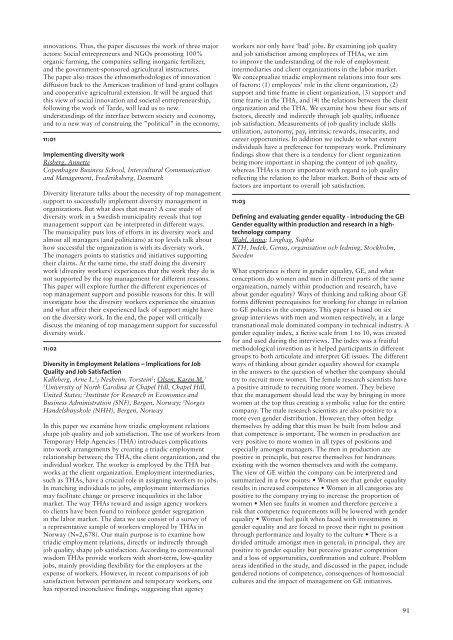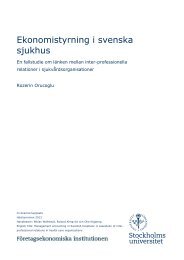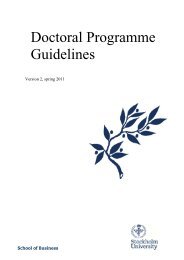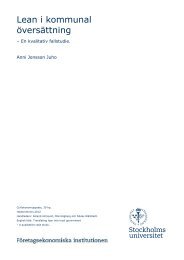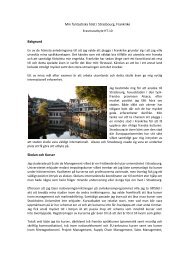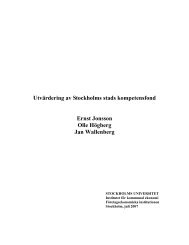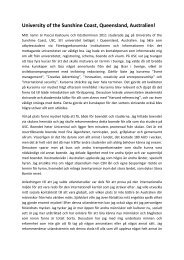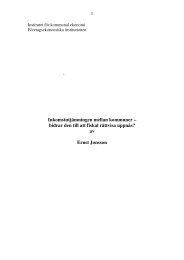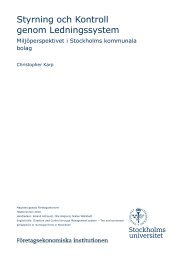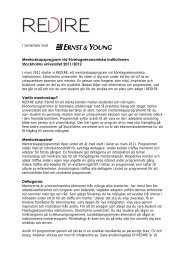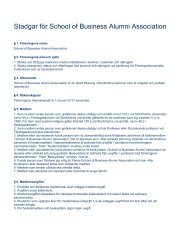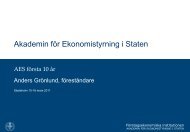Download full programme and abstract book pdf 1.6
Download full programme and abstract book pdf 1.6
Download full programme and abstract book pdf 1.6
You also want an ePaper? Increase the reach of your titles
YUMPU automatically turns print PDFs into web optimized ePapers that Google loves.
innovations. Thus, the paper discusses the work of three major<br />
actors: Social entrepreneurs <strong>and</strong> NGOs promoting 100%<br />
organic farming, the companies selling inorganic fertilizer,<br />
<strong>and</strong> the government-sponsored agricultural instructures.<br />
The paper also traces the ethnomethodologies of innovation<br />
diffusion back to the American tradition of l<strong>and</strong>-grant collages<br />
<strong>and</strong> cooperative agricultural extension. It will be argued that<br />
this view of social innovation <strong>and</strong> societal entrepreneurship,<br />
following the work of Tarde, will lead us to new<br />
underst<strong>and</strong>ings of the interface between society <strong>and</strong> economy,<br />
<strong>and</strong> to a new way of construing the ”political” in the economy.<br />
11:01<br />
Implementing diversity work<br />
Risberg, Annette<br />
Copenhagen Business School, Intercultural Communication<br />
<strong>and</strong> Management, Frederiksberg, Denmark<br />
Diversity literature talks about the necessity of top management<br />
support to success<strong>full</strong>y implement diversity management in<br />
organizations. But what does that mean? A case study of<br />
diversity work in a Swedish municipality reveals that top<br />
management support can be interpreted in different ways.<br />
The municipality puts lots of efforts in its diversity work <strong>and</strong><br />
almost all managers (<strong>and</strong> politicians) at top levels talk about<br />
how successful the organization is with its diversity work.<br />
The managers points to statistics <strong>and</strong> initiatives supporting<br />
their claims. At the same time, the staff doing the diversity<br />
work (diversity workers) experiences that the work they do is<br />
not supported by the top management for different reasons.<br />
This paper will explore further the different experiences of<br />
top management support <strong>and</strong> possible reasons for this. It will<br />
investigate how the diversity workers experience the situation<br />
<strong>and</strong> what affect their experienced lack of support might have<br />
on the diversity work. In the end, the paper will critically<br />
discuss the meaning of top management support for successful<br />
diversity work.<br />
11:02<br />
Diversity in Employment Relations – Implications for Job<br />
Quality <strong>and</strong> Job Satisfaction<br />
Kalleberg, Arne L. 1 ; Nesheim, Torstein 2 ; Olsen, Karen M. 3<br />
1 University of North Carolina at Chapel Hill, Chapel Hill,<br />
United States; 2 Institute for Research in Economics <strong>and</strong><br />
Business Administration (SNF), Bergen, Norway; 3 Norges<br />
H<strong>and</strong>elshøyskole (NHH), Bergen, Norway<br />
In this paper we examine how triadic employment relations<br />
shape job quality <strong>and</strong> job satisfaction. The use of workers from<br />
Temporary Help Agencies (THA) introduces complications<br />
into work arrangements by creating a triadic employment<br />
relationship between; the THA, the client organization, <strong>and</strong> the<br />
individual worker. The worker is employed by the THA but<br />
works at the client organization. Employment intermediaries,<br />
such as THAs, have a crucial role in assigning workers to jobs.<br />
In matching individuals to jobs, employment intermediaries<br />
may facilitate change or preserve inequalities in the labor<br />
market. The way THAs reward <strong>and</strong> assign agency workers<br />
to clients have been found to reinforce gender segregation<br />
in the labor market. The data we use consist of a survey of<br />
a representative sample of workers employed by THAs in<br />
Norway (N=2,678). Our main purpose is to examine how<br />
triadic employment relations, directly or indirectly through<br />
job quality, shape job satisfaction. According to conventional<br />
wisdom THAs provide workers with short-term, low-quality<br />
jobs, mainly providing flexibility for the employers at the<br />
expense of workers. However, in recent comparisons of job<br />
satisfaction between permanent <strong>and</strong> temporary workers, one<br />
has reported inconclusive findings, suggesting that agency<br />
workers not only have ‘bad’ jobs. By examining job quality<br />
<strong>and</strong> job satisfaction among employees of THAs, we aim<br />
to improve the underst<strong>and</strong>ing of the role of employment<br />
intermediaries <strong>and</strong> client organizations in the labor market.<br />
We conceptualize triadic employment relations into four sets<br />
of factors: (1) employees’ role in the client organization, (2)<br />
support <strong>and</strong> time frame in client organization, (3) support <strong>and</strong><br />
time frame in the THA, <strong>and</strong> (4) the relations between the client<br />
organization <strong>and</strong> the THA. We examine how these four sets of<br />
factors, directly <strong>and</strong> indirectly through job quality, influence<br />
job satisfaction. Measurements of job quality include skills<br />
utilization, autonomy, pay, intrinsic rewards, insecurity, <strong>and</strong><br />
career opportunities. In addition we include to what extent<br />
individuals have a preference for temporary work. Preliminary<br />
findings show that there is a tendency for client organization<br />
being more important in shaping the content of job quality,<br />
whereas THAs is more important with regard to job quality<br />
reflecting the relation to the labor market. Both of these sets of<br />
factors are important to overall job satisfaction.<br />
11:03<br />
Defining <strong>and</strong> evaluating gender equality - introducing the GEI<br />
Gender equality within production <strong>and</strong> research in a hightechnology<br />
company<br />
Wahl, Anna; Linghag, Sophie<br />
KTH, Indek, Genus, organisation och ledning, Stockholm,<br />
Sweden<br />
What experience is there in gender equality, GE, <strong>and</strong> what<br />
conceptions do women <strong>and</strong> men in different parts of the same<br />
organization, namely within production <strong>and</strong> research, have<br />
about gender equality? Ways of thinking <strong>and</strong> talking about GE<br />
forms different prerequisites for working for change in relation<br />
to GE policies in the company. This paper is based on six<br />
group interviews with men <strong>and</strong> women respectively, in a large<br />
transnational male dominated company in technical industry. A<br />
gender equality index, a fictive scale from 1 to 10, was created<br />
for <strong>and</strong> used during the interviews. The index was a fruitful<br />
methodological invention as it helped participants in different<br />
groups to both articulate <strong>and</strong> interpret GE issues. The different<br />
ways of thinking about gender equality showed for example<br />
in the answers to the question of whether the company should<br />
try to recruit more women. The female research scientists have<br />
a positive attitude to recruiting more women. They believe<br />
that the management should lead the way by bringing in more<br />
women at the top thus creating a symbolic value for the entire<br />
company. The male research scientists are also positive to a<br />
more even gender distribution. However, they often hedge<br />
themselves by adding that this must be built from below <strong>and</strong><br />
that competence is important. The women in production are<br />
very positive to more women in all types of positions <strong>and</strong><br />
especially amongst managers. The men in production are<br />
positive in principle, but reserve themselves for hindrances<br />
existing with the women themselves <strong>and</strong> with the company.<br />
The view of GE within the company can be interpreted <strong>and</strong><br />
summarized in a few points: • Women see that gender equality<br />
results in increased competence • Women in all categories are<br />
positive to the company trying to increase the proportion of<br />
women • Men see faults in women <strong>and</strong> therefore perceive a<br />
risk that competence requirements will be lowered with gender<br />
equality • Women feel guilt when faced with investments in<br />
gender equality <strong>and</strong> are forced to prove their right to position<br />
through performance <strong>and</strong> loyalty to the culture • There is a<br />
divided attitude amongst men in general; in principal, they are<br />
positive to gender equality but perceive greater competition<br />
<strong>and</strong> a loss of opportunities, confirmation <strong>and</strong> culture. Problem<br />
areas identified in the study, <strong>and</strong> discussed in the paper, include<br />
gendered notions of competence, consequences of homosocial<br />
cultures <strong>and</strong> the impact of management on GE initiatives.<br />
91


